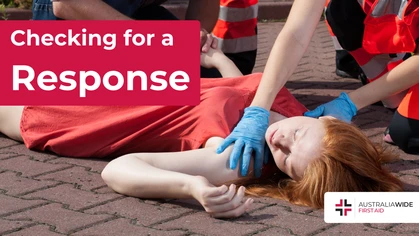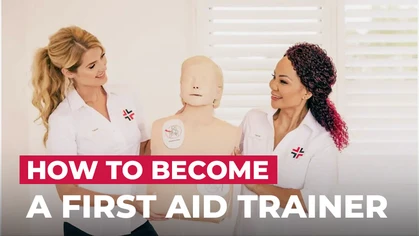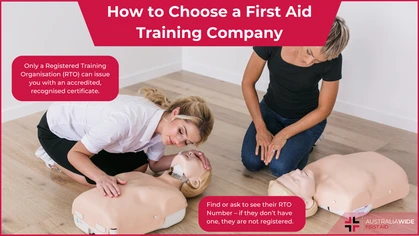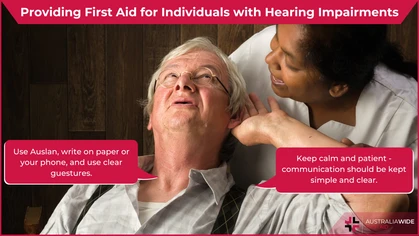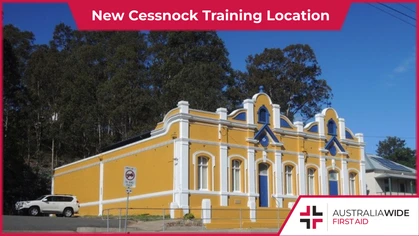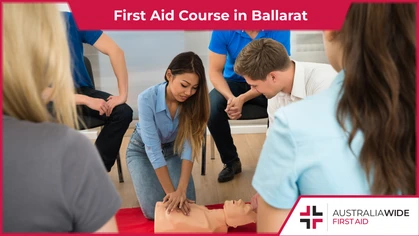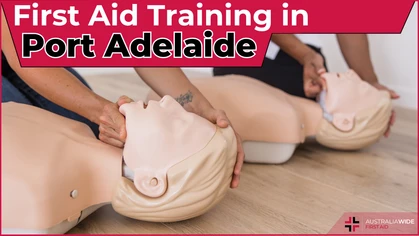What Will I Learn in a First Aid Course?

First Aid Training

First aid certificate holders have a distinct advantage in the cut and thrust of a competitive job market. Their willingness to undertake first aid training demonstrates a willingness to accept responsibility, to take initiative, and to care for others.
An accredited Australian first aid course focuses on learning how to respond to an emergency involving injury or sudden illness. The importance of this knowledge cannot be overstated. First aid knowledge should be taught in an effective, enlightening, and engaging manner. Your first aid trainer should have the right mix of skills to help you understand how first aid is provided in real-world situations. It's likely you will have read the relevant sections of your first aid manual prior to arriving at your practical session for hands-on first aid training. Your first aid instructor will build on the information from your manual by talking you through scenarios that are likely to happen in real life. Some of these scenarios will illustrate the nature of the unexpected, as it is important for first aiders to be prepared in the face of the unexpected. Though emergencies can come in all shapes and sizes, they can all be addressed using a particular first aid procedure. As such, while your first aid training will not give you super powers, nor earn you a medical degree, it will help develop your ability and confidence to deal with a wide variety of emergency situations.DRSABCD
DRSABCD is the strategy for handling emergency medical situations. It’s a strategy without borders and has been adopted across the world. The acronym expands as follows:- D is for Danger. Assessing the scene for danger is vitally important. You need to assess whether there is any immediate threat to injured person/s, bystanders, or yourself. Danger could include flames, live wires, passing vehicles, or a violent person. Casualties could suddenly multiply if this step were ignored.
- R is for Response. You need to know if the person can respond to you, as this information will help determine the actions taken in the steps that follow.
- S is for Send for Help. It may take time for professional medical care to arrive. As such, it is better to contact them sooner rather than later.
- A is for Airway. Breathing will be compromised if the person’s airway is obstructed. As such, you need to check for any obstructions and clear them without delay.
- B is for Breathing. Check that the person is breathing. B follows hot on the heels of A. If they are not breathing, proceed immediately to C.
- C is for CPR. CPR is an absolute life-saver and comes into play on many occasions, especially after cardiac arrests and near-drownings.
- D is for Defibrillator. Similar to CPR, an AED (automated external defibrillator) is used specifically to jumpstart the heart. In emergency situations, an AED can sometimes be found nearby. Other times, it is not until the paramedics arrive that an AED becomes available.
Emergency Response Procedures
As mentioned previously, you will be taught CPR in your first aid training. In an Australia Wide First Aid course, you will perform the CPR procedure on a manikin positioned on the floor. You will be kneeling over the manikin and will need to be capable of keeping the momentum going for 2 minutes solid. You will be shown the correct procedure for performing CPR on adults, children, and infants. The developing anatomy of children and infants requires adjustment to the technique. You will benefit by learning to manage this confidently. Traditional CPR procedure includes two rescue breaths after 30 chest compressions. You will also learn how to provide compression-only CPR where the potential for infection is a concern. You will be shown how the conductive pads for Automated External Defibrillators are applied safely, including how to position them on the smaller bodies of children.Treating Wounds
Your first aid training also includes wound care — from treating cuts, bruises, eye injuries, and burns, through to bandaging sprains and dislocations. The different categories for burns will also be discussed, and you will understand why dislocations are not simply ‘popped’ back into place. Likewise, you will be shown procedures that are best when there has been an injury to the neck, spine, or head.Breathing and Choking
After studying first aid, you will know what do when a person is choking or is otherwise unable to breathe, regardless of whether they are an adult or an infant. You will also learn the recommended procedure for clearing a person's airway. Likewise, you will gain insight into the nature of asthma and anaphylaxis. These two afflictions often present with similar symptoms and can escalate quickly. As such, timely first aid assistance is essential.Poisoning
When a casualty's health starts to decline as a result of poisoning, the offending substance may not be immediately apparent. This can be difficult, as the poison from an insect bite, such as that of a Sydney funnel-web spider, would need to be treated differently compared to the poison of an ingested chemical. Your first aid course will explore the different possibilities for poisoning and the first aid procedures for each.Assessing the Scene
Along with preparing you to respond to unexpected medical emergencies, from strokes and sprains to hyperthermia and hypoglycaemia, your first aid training will teach you how to sensibly assess the scene of an emergency. It is critical that you proceed safely and remain alert to potential dangers, as you cannot provide first aid if further harm is present to anyone. As such, removing the threat or moving a safe distance from it is a priority. Awareness to dangerous situations plays a significant role in preventing medical emergencies, as it can help you assess the potential for injury in your workplace and home.Flexible First Aid Training
With Australia Wide First Aid, first aid instruction is available at venues around Australia. Another option is to have one of the company’s exceptional trainers come to your premises to deliver a group first aid class. This training can be customised to suit your workplace, addressing such safety concerns as working with chemicals on-site, working with potentially dangerous machinery, working at heights, as well as many other health and safety situations. Once you’re enrolled in an Australia Wide First Aid course, you can download your first aid manual in eBook form. The relevant sections to read depend on the course you signed up for. Reading the eBook in its entirety will not take much extra effort in any case. If you are strapped for time, you could use your first aid eBook as a handy reference to quickly find the answers to the eLearning quiz, and save the reading for later. The online first aid course with Australia Wide First Aid is a breeze. It is a multiple-choice quiz you can tackle over several short sessions, or in one hit. Take as many attempts as you need to arrive at the correct answers. You will have scored 100% when your eLearning is completed. There is less stress when you get your eLearning done rather than leave it until the last moment. However, you do have until 11:59 pm the night before your first aid class to submit your assessment. Regulations require eLearning to be completed before the hands-on training. If you were to try to attend the practical session without having submitted your eLearning, you would be turned away and would need to rebook the first aid workshop… another reason it’s less stressful to just get it done.Your First Aid Certificate
First aid certification is not just a way of becoming more valuable to your community, it is also a genuine career booster. Your first aid certificate tells employers that you readily accept responsibility, that you care for the people around you, and that you know how to take the initiative. Australia Wide First Aid certificates are recognised in every state and territory in Australia. As such, in the cut and thrust of a competitive job market, the first aid certificate holder has a distinct advantage. Graduates of any first aid course can simply do refresher courses to keep their qualifications intact and up-to-date. CPR (HLTAID009) should be renewed annually. Meanwhile, renewal every 3 years is recommended for HLTAID011 Provide First Aid and HLTAID012 Provide First Aid in an education and care setting.
Originally published at
https://www.australiawidefirstaid.com.au/resources/what-will-i-learn-in-a-first-aid-course
as part of the Australia Wide First Aid Articles Library
